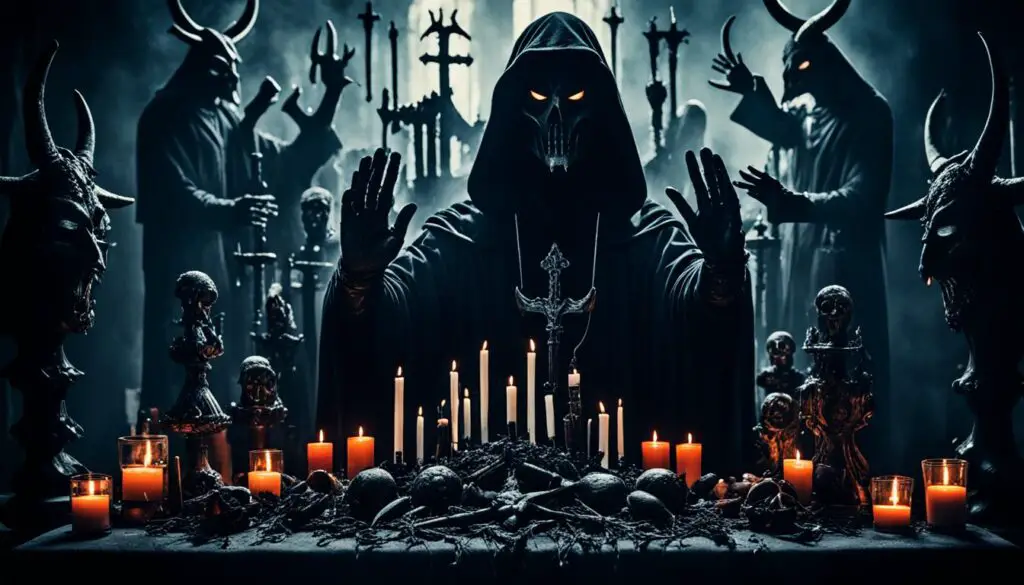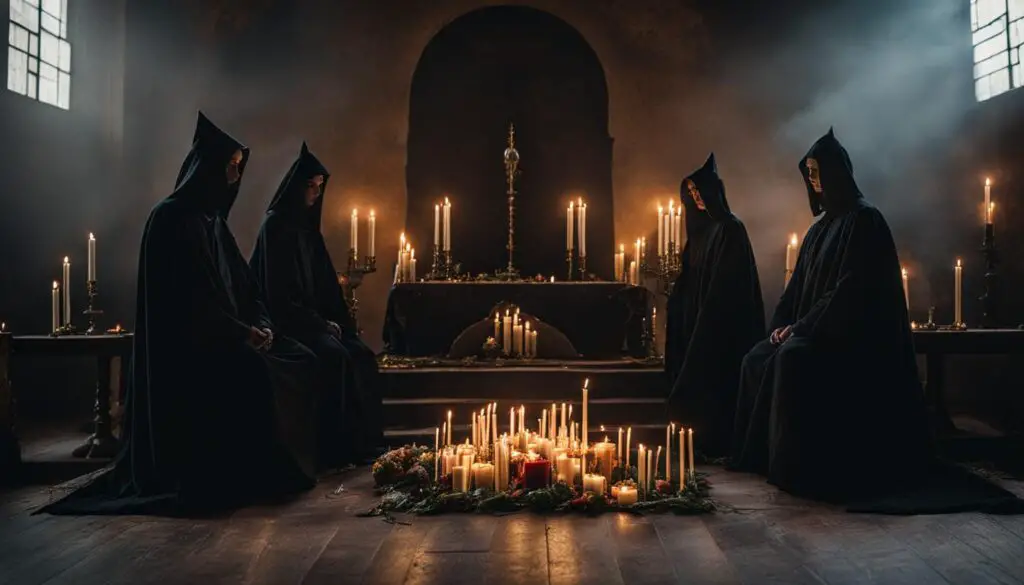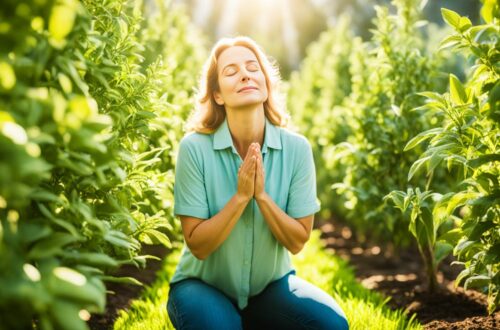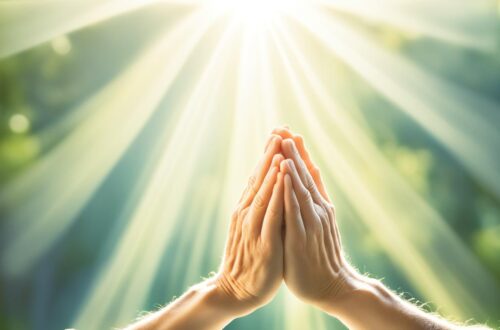Welcome to our in-depth exploration of Halloween, a holiday shrouded in mystery and folklore. In this article, we aim to uncover the truth about a widely held belief: Is Halloween truly the devil’s birthday? Join us on this fascinating journey as we delve into the origins of Halloween, examine its historical significance, and separate fact from fiction.
For centuries, the association between Halloween and the devil has captured the imaginations of many. But is there any substance to this belief, or is it merely a product of folklore and superstition? Let us embark on a quest for truth and knowledge, drawing upon historical records and cultural insights to shed light on this age-old myth.
Key Takeaways:
- Discover the origins of Halloween and its evolution throughout history.
- Explore the misconceptions surrounding Halloween’s supposed connection to devil worship.
- Uncover the pagan celebrations and traditions that influenced Halloween.
- Gain insights into the symbolism of Halloween and its deeper meaning.
- Examine the global variations of Halloween celebrations, showcasing diverse cultural practices.
Understanding Halloween’s Origins
Delving into the rich history of Halloween allows us to unravel the mysteries that enshroud this captivating holiday. As we explore its origins and evolution, we gain a deeper appreciation for its cultural significance and can better discern the truth behind the notion of Halloween being the devil’s birthday.
The roots of Halloween can be traced back to ancient Celtic festivals, particularly the Gaelic festival of Samhain. Celebrated on the eve of October 31st, it marked the end of the harvest season and the beginning of winter. It was believed that on this night, the boundary between the living and the spirit world was blurred, allowing the supernatural to roam freely among humans.
In Ireland and Scotland, people would light bonfires and wear costumes to ward off these roaming spirits. The wearing of disguises also served as protection, as it was believed that evil spirits could be fooled by assuming a different identity. This tradition eventually became part of the Halloween we know today, where costumes are donned to represent various supernatural beings.
Over time, Halloween incorporated elements of Roman and Christian traditions. The Roman festival of Pomona, honoring the goddess of fruit and trees, added the custom of bobbing for apples. With the spread of Christianity, the holiday also took on religious significance as All Hallows’ Eve, the evening before All Saints’ Day, honoring saints and martyrs.
The merging of various cultural practices and beliefs culminated in the Halloween we celebrate today. Its roots in ancient pagan festivals, combined with Christian observances and folk customs, have shaped the holiday into a unique blend of traditions and symbolism.
As we uncover Halloween’s origins and explore its historical journey, we can appreciate the diverse influences that have shaped this beloved holiday. Stay with us as we continue our exploration, separating fact from fiction and embracing the true spirit of Halloween.
Separating Fact from Fiction: Halloween and Devil Worship
There has long been a misconception that Halloween is deeply intertwined with devil worship and satanic rituals. However, when we examine the historical evidence, we find that this association is largely a fabrication. Halloween, also known as All Hallows’ Eve, has its roots in ancient Celtic traditions and the Christian holiday of All Saints’ Day, rather than any sinister or demonic practices.

The notion of Halloween as a celebration of evil and devilry likely stems from a confluence of factors, including cultural misunderstandings, fictional portrayals, and sensationalized accounts. While Halloween has been associated with spooky imagery and supernatural themes, it is essential to distinguish between playful festivities and genuine devil worship.
Historically, Halloween was a time when communities came together to honor their ancestors, ward off evil spirits, and celebrate the harvest season. People would dress up in costumes and carve turnips or pumpkins to ward off malevolent entities.
To truly understand the nature of Halloween, it is important to recognize its cultural significance and the joyous spirit in which it is celebrated. Halloween offers an opportunity for people of all ages to embrace their creativity, indulge in harmless scare, and strengthen community bonds.
So, as we explore the rich history of Halloween, let us dispel the misguided notion that it is synonymous with devil worship. Instead, let us appreciate the joy, togetherness, and sense of wonder that this cherished holiday brings.
Pagan Celebrations and Halloween Traditions
As Halloween approaches, it’s fascinating to explore how this beloved holiday’s traditions may have originated from ancient pagan celebrations. By understanding the cultural and religious practices that influenced Halloween, we can gain valuable insights into its true meaning.
Many of the customs and rituals associated with Halloween can be traced back to the ancient Celtic festival of Samhain. Samhain marked the end of the harvest season and the beginning of winter in the Celtic calendar. It was believed that on the night of October 31st, the boundary between the living and the spirit world was the thinnest, allowing spirits to walk among the living.
This belief led to the tradition of wearing costumes and masks during Halloween, originating from the ancient Celtic practice of disguising oneself as a way to confuse and ward off malevolent spirits. The custom of carving pumpkins into jack-o’-lanterns also finds its roots in Samhain, where turnips or other root vegetables were originally carved and used as lanterns to guide ancestral spirits.
Another significant influence on Halloween traditions comes from the Roman festival of Pomona, which honored the goddess of fruit and trees. Pomona’s symbol was the apple, which is believed to have inspired the tradition of bobbing for apples on Halloween.
These ancient traditions gradually merged with Christian beliefs as the Catholic Church sought to replace pagan festivities with church-sanctioned celebrations. The church designated November 1st as All Saints’ Day, also known as All Hallows’ Day. The night before, October 31st, became All Hallows’ Eve, eventually shortened to Halloween.
Today, Halloween traditions vary around the world but still retain the essence of its ancient pagan origins. This fusion of cultures and traditions has given Halloween its unique character, where celebrations now include costume parties, trick-or-treating, haunted houses, and the enjoyment of spooky tales.
By exploring the connections between Halloween and ancient pagan celebrations, we not only gain a deeper appreciation for the holiday but also recognize the cultural and historical significance embedded in its traditions. Halloween serves as a reminder of our shared human history and the enduring customs that unite us across time and continents.
Understanding Satanic Rituals
Within the realm of Halloween and its associations with the supernatural, it is only natural to explore the topic of Satanic rituals. Satanic rituals encompass a variety of practices and beliefs that are often misunderstood and sensationalized.
To better understand the distinctions between Halloween and satanic worship, it is crucial to separate myth from reality. Satanic rituals are rooted in various ideologies and typically involve the invocation, worship, or celebration of dark forces or entities.
Contrary to popular belief, these rituals are not exclusive to Halloween and are practiced by a small subset of individuals who identify with the Satanic tradition. It is important to note that Satanic rituals are not representative of the majority’s beliefs or practices during Halloween.
By shedding light on the practices and beliefs associated with Satanic rituals, we can gain a more comprehensive perspective on the different aspects of Halloween and their cultural significance. Let us now explore the fascinating world of Satanic rituals and their connection, or lack thereof, to the widely celebrated holiday of Halloween.

The Commercialization of Halloween
Over the years, Halloween has evolved from a humble pagan celebration steeped in tradition to a highly commercialized holiday that dominates store shelves and captures the public’s imagination. The influence of consumerism has significantly impacted the perception and understanding of this once sacred occasion, leading to misconceptions about its true nature.
Today, Halloween has become synonymous with costumes, candy, and elaborate decorations. The market is flooded with a wide range of themed merchandise catering to individuals of all ages. From whimsical costumes to spooky home decor, there seems to be no shortage of commercial offerings when it comes to embracing the Halloween spirit.
The commercialization of Halloween has led to a shift in focus from its pagan origins and traditional Halloween traditions. Rather than reflecting on the rich cultural and historical significance of the holiday, many people now associate Halloween with materialistic indulgence and superficial celebration.
However, it is important to recognize that the underlying essence of Halloween has not been completely lost amidst the commercial frenzy. Behind the flashy costumes and lavish parties, there still exists a deep-rooted connection to ancient pagan celebrations and Halloween traditions.
For those seeking a more meaningful Halloween experience, it is essential to look beyond the consumerism and rediscover the true spirit of this holiday. Exploring the origins of Halloween, understanding its pagan roots, and embracing the rich tapestry of Halloween traditions can help cultivate a deeper appreciation for this ancient celebration.
In the next section, we will delve into the symbolism of Halloween, uncovering the hidden meanings behind costumes, jack-o’-lanterns, and other iconic elements. By exploring the symbolic aspects of Halloween, we can gain an even deeper understanding of its spiritual and cultural significance.
Exploring the Symbolism of Halloween
Halloween, with its vibrant costumes, flickering jack-o’-lanterns, and eerie decorations, is a holiday steeped in symbolism. These symbols have become synonymous with the celebration, creating an atmosphere of mystery and enchantment. By delving into the meaning behind these symbols, we can unlock a deeper understanding of the true essence of Halloween.
The Costume: Unleashing Creativity and Identity
One of the most iconic symbols of Halloween is the costume. Donning a costume allows individuals to embody different characters and personas, transcending their everyday identities. It is a chance to tap into their creativity and express a side of themselves that might otherwise remain hidden. Whether dressed as a spooky creature or a beloved fictional character, the costume becomes a powerful tool for self-expression and exploration.
Jack-o’-Lanterns: Warding Off the Supernatural
No Halloween would be complete without the flickering glow of jack-o’-lanterns. These carved pumpkins, with wicked grins or intricate designs, have a rich folklore behind them. Originally, they served as protective lanterns, placed outside homes to ward off evil spirits on All Hallows’ Eve. Today, these illuminated gourds are a symbol of welcoming and protection, guiding trick-or-treaters through the night.

Spooky Decorations: Embracing the Mystical
From spider webs to skeletons, Halloween decorations evoke a sense of the macabre and mysterious. These ornamental elements create an ambience that embraces the supernatural and unknown. They represent a celebration of the darker aspects of life and our fascination with the mystical. While they may seem unsettling, they remind us of the power of embracing our fears and finding joy in the thrill of the unknown.
Through costumes, jack-o’-lanterns, and spooky decorations, Halloween symbolism weaves a narrative of self-expression, protection, and embracing the mysterious. These symbols serve as a gateway to the holiday’s true essence, inviting us to tap into our creativity, ward off negativity, and celebrate the magic and enchantment that Halloween brings.
Celebrating Halloween around the World
As Halloween approaches, people around the world prepare for a night of ghoulish delights and spooky festivities. While Halloween is traditionally celebrated in countries with Western influences, its popularity has spread to various corners of the globe. Let’s take a journey to discover how this bewitching holiday is celebrated in different parts of the world.
Halloween in Mexico: Dia de los Muertos
Halloween, known as Dia de los Muertos or Day of the Dead, is a vibrant and colorful celebration in Mexico. Families honor their deceased loved ones by creating elaborate altars adorned with marigolds, candles, and sugar skulls. They also visit cemeteries to clean and decorate the graves, offering food, beverages, and personal belongings to the departed spirits.
Halloween in Ireland: Samhain
Halloween, originally derived from the ancient Gaelic festival of Samhain, holds a special place in Ireland’s heart. Traditions include lighting bonfires, telling ghost stories, and carving turnips or pumpkins into menacing faces. The enchanted atmosphere brings communities together to celebrate the changing seasons and honor the spirits of loved ones.
Halloween in Japan: Obon Festival
In Japan, Halloween coincides with the Obon Festival, a time to pay respects to ancestors. Families clean and decorate graves, light lanterns, and participate in traditional dances. Some neighborhoods organize parades, costume contests, and street fairs infused with both Halloween and Obon themes, blending ancient traditions with modern interpretations.
Halloween in Scotland: Guising
In Scotland, Halloween is celebrated with a charming tradition known as guising. Children dress up in costumes and go door-to-door, reciting poems, telling jokes, or performing songs in exchange for treats. This Scottish custom, which predates the modern trick-or-treating tradition, adds an enchanting twist to Halloween celebrations.
Halloween in Guyana: John Canoe Festival
Among the vibrant culture of Guyana in South America, Halloween is intertwined with the John Canoe Festival. This festival features dancers parading through the streets in extravagant costumes, accompanied by music and vibrant celebrations. The fusion of Halloween and local traditions creates a lively and unique experience for all.
In every corner of the world, Halloween is celebrated in its own unique way, blending cultural traditions and ancient practices. From vibrant festivals to heartfelt rituals, these international celebrations illustrate the universality of human fascination with the supernatural and the power of community.
Halloween and Spirituality
Halloween is not just about costumes and candy; for many, it holds a deeper spiritual significance. Beyond its historical roots and cultural traditions, Halloween has become a time for individuals to explore and embrace their spirituality.
During this enchanting season, people from various spiritual paths find solace and connection with the spiritual realm. Some see Halloween as a sacred time to honor and communicate with their ancestors, seeking guidance and wisdom from those who came before them.
Others view Halloween as a potent opportunity to connect with their own inner spirituality, using the holiday as a catalyst for personal growth and self-reflection. It becomes a time to let go of the old, release what no longer serves, and embrace transformation.
Halloween offers a unique blend of darkness and light, echoing the eternal dance between life and death. It encourages introspection, reminding us of the cyclical nature of existence and the importance of reconnecting with our souls.
For many, Halloween provides a powerful space for ritual and ceremony. Whether it’s creating altars adorned with symbolic objects, participating in guided meditations, or performing sacred rituals, these practices help individuals tap into their spiritual essence.
As we journey through the mystical energies of Halloween, we can uncover a deeper understanding of our own spirituality. It allows us to explore the mysteries of the universe, connect with the divine, and embrace the magic that lies within and around us.
Halloween is a time to honor the spiritual aspects of life and death, inviting us to reflect on our purpose, connect with our inner wisdom, and appreciate the interconnectedness of all things. So, as we celebrate this bewitching holiday, let us embrace the spiritual dimensions of Halloween and allow its enchantment to awaken our souls.
Debunking Misconceptions: Halloween Today
Halloween is a holiday that has been steeped in myths and misconceptions for centuries. In contemporary society, many stereotypes and misunderstandings continue to surround this popular celebration. It is time to separate fact from fiction and debunk these Halloween misconceptions that have persisted for far too long. By gaining a clearer understanding of Halloween’s true nature, we can fully embrace this festive occasion.
The True Spirit of Halloween
One common misconception is that Halloween is a celebration of darkness, evil, and the devil’s birthday. However, this belief couldn’t be further from the truth. Halloween is actually rooted in ancient traditions and has deep connections to various cultural and spiritual practices.
Unmasking the Stereotypes
Another misconception is that Halloween is solely about scary costumes, haunted houses, and ghostly encounters. While these elements are certainly part of the fun, they do not define the entire holiday. Halloween is a time for creativity, self-expression, and community. It is a celebration of imagination, where people of all ages come together to embrace their playful and whimsical sides.
Halloween’s Cultural and Historical Significance
Halloween is often dismissed as a frivolous, commercialized holiday. However, this overlooks the rich cultural and historical significance behind the traditions we observe today. From its roots in ancient Celtic harvest festivals to the blending of Christian and pagan customs, Halloween has evolved into a unique celebration that reflects a tapestry of world cultures.
Embracing the True Essence of Halloween
This Halloween, let us debunk these misconceptions and embrace the true essence of the holiday. It is a time to connect with our loved ones, engage in festive activities, and celebrate the beauty of autumn. Let go of the preconceived notions and allow yourself to fully immerse in the joy and excitement that Halloween brings.
The Evolution of Halloween
Halloween, with its vibrant traditions and spooky festivities, has a fascinating history that spans centuries. Over time, this beloved holiday has evolved and adapted to various cultural contexts, becoming a celebration cherished by people around the world.
From its ancient origins to modern-day observances, Halloween has undergone significant transformations, incorporating diverse customs and beliefs along the way. This evolution has shaped the holiday into what we know and love today, with its unique blend of Halloween traditions and rich historical significance.
Halloween’s journey can be traced back to ancient Celtic traditions, particularly the festival of Samhain, which marked the end of the harvest season and the beginning of winter. It was believed that during Samhain, the boundary between the living and the spirit world became blurred, allowing spirits to roam freely among the living. To appease these spirits, people would light bonfires and wear masks and costumes.
As Christianity spread across Europe, the Celtic festival of Samhain gradually merged with Christian practices. Pope Boniface IV dedicated November 1 as All Saints’ Day, also known as All Hallows’ Day, which incorporated elements of Samhain. The night before, known as All Hallows’ Eve, eventually became Halloween.
Throughout the centuries, Halloween continued to evolve, drawing influences from various cultures and traditions. In the United States, the holiday assimilated customs from Irish and Scottish immigrants in the 19th century, such as trick-or-treating and carving pumpkins into jack-o’-lanterns. These practices, rooted in ancient folklore, became iconic symbols of Halloween.
The commercialization of Halloween in the 20th century further shaped the holiday’s image. Costumes, haunted attractions, and themed parties became prevalent, catering to the demand for a thrilling and immersive Halloween experience.
Today, Halloween embraces a diverse range of customs and practices, reflecting the multicultural nature of our society. It is celebrated with costume parties, community events, haunted houses, and festive decorations. From elaborate costumes inspired by pop culture to traditional harvest festivals, Halloween has become a holiday that invites individuals to express their creativity and embrace the spooky spirit.
The evolution of Halloween showcases its remarkable adaptability and enduring appeal. As it continues to transcend cultural boundaries, Halloween remains a cherished occasion that brings people together, fostering a sense of joy, playfulness, and community.
Conclusion
After thoroughly examining the origins and historical significance of Halloween, it is clear that the notion of it being the devil’s birthday is nothing more than a myth. Halloween, rooted in ancient traditions and customs, has evolved over time to become a widely celebrated holiday worldwide.
The origins of Halloween can be traced back to ancient Celtic festivals such as Samhain, which marked the end of the harvest season and the beginning of winter. While certain elements of Halloween may have pagan roots, its modern-day celebration is largely devoid of any satanic connotations.
Despite misconceptions linking Halloween to devil worship, it is important to understand that the holiday holds different meanings for different people. For many, it is simply a time to embrace the spooky and supernatural, dress up in costumes, and indulge in festive activities.
In conclusion, Halloween should be appreciated for what it truly is: a holiday that allows individuals to express creativity, celebrate community, and enjoy the excitement and mystery that is associated with this autumnal event. Let us embrace the true origins of Halloween and continue to enjoy its festivities without the fear of the devil’s birthday overshadowing the joyous spirit of the holiday.





